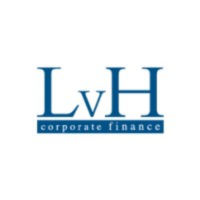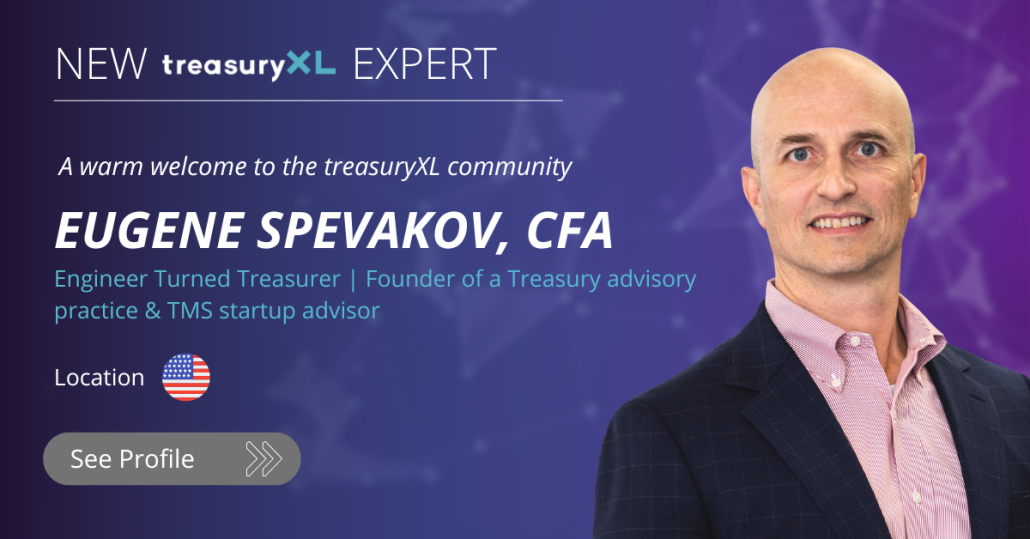Interview | 8 Questions for Eugene Spevakov, the New treasuryXL Expert
By treasuryXL
We are very excited to introduce our newest treasuryXL expert for our community: Eugene Spevakov.
With over 20 years in Treasury and Finance, Eugene’s background blends engineering problem-solving with financial strategy. He has worked with both public companies and high-growth startups, focusing on scaling financial operations, managing cash, and mitigating risk. Eugene’s approach always challenges assumptions and adapts solutions based on what’s needed for growth and success.
Eugene has led teams in Treasury, Corporate FP&A, and operational finance, guiding companies through crucial stages of growth while fine-tuning financial processes and systems. He has structured and executed key financial initiatives, helping companies secure funding and optimize their investments. More recently, Eugene launched an advisory practice, assisting businesses without dedicated Treasury teams to elevate their financial planning and risk management practices.
In addition to his corporate work, Eugene serves as an advisor for a Treasury Management System startup and as Treasurer at BetterGrids Foundation. He holds an MBA from UC Davis, a B.S. in Civil Engineering from UC Berkeley, and is a CFA Charterholder. We’re excited for Eugene to bring his wealth of experience to our treasuryXL community.
We asked Eugene 8 questions in this exclusive interview. Have fun reading!
INTERVIEW
Can you share how your career journey evolved and what led you to focus on Treasury and finance?
I started out as an Engineer and worked for AT&T designing and implementing construction projects (outside plant), which was a lot of fun. I really liked it because I could see the finished product, which gave me a sense of accomplishment. After several years, I pursued my MBA and then came back to AT&T to join a rotational program called Finance Leadership Program. It was a great experience and for my last rotation I was fortunate to join AT&T Treasury.
Over the years, I have changed companies while staying in the Treasury, steadily expanding the breadth of my role and level of responsibility. I also had an opportunity to go beyond Treasury and led several other Finance functions within FinOps and FP&A.
There were many times in my career when I would pick up new responsibilities, whether at the same employer or by joining a new company. While I was at SanDisk, my initial focus was on FX, but after a couple of years, I was promoted and given a larger role that included Investments too. This was an excellent opportunity to lead both functions because FX was a serious risk for SanDisk, given its obligations to purchase a large portion of wafers in Japanese Yen. At the same time, the company held billions of cash on the balance sheet, which we invested in short-term, high-grade fixed income.
What motivated your transition from engineering to finance, and how did you adapt your skills from one field to the other?
To be honest, when I set out on a full-time MBA program, Finance was just one of the options I was considering. I was leaning more toward Project Management, given that I have enjoyed it in the past.
However, I quickly found parallels between Finance and Engineering as both were very analytical fields, and I pivoted to Finance. I found the combination of Economics, Statistics, Risk Management, and various market theories fascinating and loved diving into it.
What sparked your interest in FX, and how did it become such an important part of your career?
My journey into FX was somewhat random. First, as I joined AT&T and started doing Corporate Finance rotations at a BU level, I became somewhat disillusioned with Finance. I must be honest that I didn’t see the big picture of Finance at the time and felt like a cog in a big machine. Targets were handed down from above and my job was to back into those targets. It was more about finessing the numbers and less about any strategic or complex financial analysis.
I was very happy to get to Treasury as my final rotation where so much of the work was connected to external markets and market forces rather than arbitrary budget targets. At that point I also had a ‘full company’ vantage point rather than just BU. Almost as soon as I started my Treasury rotation, a person dedicated to FX left AT&T, and I’m very grateful to my manager for letting me take on the FX function at that time.
Years later, I recalled how when I was 13 years old living in the Soviet Union, I had an opportunity to travel to Yugoslavia (it was still a country back then) to compete in a sports event. The Soviet Union had very strict travel rules, one of which was that if you did travel abroad, once a year you could exchange local currency (roubles) into hard currency such as USD at an official government rate which was extremely favorable (rouble was not convertible and black market rates were an order of magnitude worse than the official rates).
I found the idea of FX exchange rates so fascinating at that time. Due to no merit or fault of your own, the amount of money that you would receive on any single day could have a significant fluctuation. That was a completely novel concept and given my upcoming trip, which came with this strange opportunity to convert roubles to USD, I started monitoring FX rates and paying attention to them. I didn’t think much of it at the time, but it laid some of the foundation for my interests later in life.
Could you walk us through your experience managing large-scale investment portfolios? What were the key factors that contributed to their success?
When I was working at SanDisk, I had an opportunity to manage an investment program for a company that had billions of dollars in cash. This gave me a chance to work with external asset managers and leverage some of the principles about the markets and fixed income investments that I have learned while studying for the CFA exams. It was a great experience to learn about various types of investments within short-term, high-grade fixed income and tie back to managing the liquidity of corporate cash.
SanDisk at the time had a relatively high tax rate and it made sense to invest in tax-exempt securities such as Municipal Bonds. It was very interesting to learn about this asset class and be somewhat of an outlier among other companies, most of which did not invest in munis as heavily as we did at that time.
What are some of the challenges you have encountered when implementing large FX hedging programs, and how did you overcome them?
I initially approached FX hedging in a very programmatic and theoretical way, based on the risk management and hedging principles I learned while studying for the CFA exams. One issue I quickly ran into was that, from an FX Manager’s perspective, it’s easy to suggest a certain course of action. But from the perspective of someone responsible for the outcome of the entire company’s performance, these decisions are not straightforward. There could be second-guessing, and I always faced the challenge of how to mitigate the downside while still capturing the upside.
Part of the solution was framing the discussion in terms of risk management, rather than focusing on opportunity lost or gained. Another part was providing solid analysis to demonstrate things like Value at Risk and give executives options for mitigating risk. Risk is a difficult concept, so it’s important to have a clear narrative of what it is, which risks are better to take, and how to handle risks you don’t want to take.
For FX hedging, my work at SanDisk stands out because of the company’s large exposure to Japanese Yen (about half of COGS were denominated in JPY). When I joined SanDisk, JPY was strengthening, which caused a lot of pain. I proposed a very programmatic approach to hedging with a focus on FX risk. The management liked this approach, and we adopted a new hedging program where we would hedge more systematically and change the instrument mix (moving from collars to using more forwards).
However, even within this overall framework, there were still decisions to be made on timing and amounts. These decisions were difficult to make, and there was a natural tendency to second-guess them because of how large an impact each decision could have on the company’s performance (in hindsight). I’ve done FX hedging (both Balance Sheet and Cash Flow) at other companies since my time at SanDisk, but I’ve never seen the same level of FX risk exposure, where hedging decisions were so critical.
When managing complex insurance programs, what are some unique challenges you have faced, and how did you address them?
First, I have to say that Insurance is a very different animal within this fragmented mosaic of a Treasury function. It also has its own lingo that one learns over time, and which appears daunting to newcomers. One benefit I had when I first picked a responsibility for Insurance is that, as a newcomer, I got to ask stupid questions… I had an excuse, I was new to this. And while many questions were trivial, many others were good questions that one was right to ask to challenge the existing status quo.
At the end of the day, I believe that things are done for a reason, and we have to ask questions to understand what that reason is of why we do things a certain way. And if the reason for doing something is not strong enough, we should ask what the alternatives are.
With Insurance, another important paradigm for me was that the purpose of Insurance is to transfer Risk. To do this effectively, the key is to reduce uncertainty, which is risk in itself. Therefore, it is imperative to have strong communication between the insured and the underwriter and to establish a risk narrative. Nobody understands the risk of the insured like the insured does, and it is generally important to let the underwriter understand it as much as possible. Otherwise, they have to fill in the blanks themselves and they would usually err on the side of caution.
What is your approach to building and scaling Treasury and other finance functions in a startup environment, and how does it differ from working in larger, more established companies?
In a startup environment, everything seems to move faster, many things are not established yet, and you are frequently playing catch-up. Instead of planning for the future, you end up responding to something that got broken as you were scaling. My philosophy is that you shouldn’t just solve for the problems of today but solve for the problems of tomorrow. Understand what problems you will face at scale and what the best practices are to address these challenges.
I am a proponent of building scalable processes early on and planning on what systems you will eventually need to automate and streamline these processes. My suggestion is to implement a scalable process and controls early on. Often, there is no reason for a smaller and growing company not to have the same rigor as a more established company. For example, I have established a separately managed account for investments earlier than many companies would. It was not a very heavy lift, and it made navigating SVB collapse much easier because most of the funds were at a custody account with another bank at the time. The same goes for FX risk as another example. You don’t necessarily have to launch an FX hedging program, but it is very helpful to assess and understand your risk so you can make informed decisions.
What’s the best piece of advice you would offer to Treasury professionals? And what can the treasuryXL community expect from you moving forward?
My advice to other Treasury professionals, especially those who are early in their careers, is to try to understand the big picture. Don’t just focus on ‘how’ but try to understand ‘why’. Define what the role of Treasury in a particular organization is and how you help achieve the objectives of Finance and the Company as a whole. Be proactive instead of reactive and turn Treasury into a strategic function (that means go beyond blocking and tackling) for the Company.
I plan on doing webinars and joining discussions about specific topics within the Treasury realm, as well as the role of Treasury in general and how to elevate it.
THANK YOU
Thank you, Eugene, for sharing your experiences and knowledge.
Eugene’s unique approach to blending engineering and finance really stands out. It was fascinating to hear about Eugene’s work in capital markets and risk management, particularly in scaling financial operations for growing companies. Eugene’s perspective on working with startups and advisory roles offers valuable lessons for many in the industry!
We are excited to continue following Eugene’s journey and are looking forward to hearing more from him. Eugene’s expertise will be a fantastic addition to the treasuryXL community!
Can’t get enough? Check out these latest items
 https://treasuryxl.com/wp-content/uploads/2024/08/Surecomp-BLOGS-featured-3.png
200
200
treasuryXL
https://treasuryxl.com/wp-content/uploads/2018/07/treasuryXL-logo-300x56.png
treasuryXL2025-12-09 07:00:012025-12-08 16:15:18Trade Finance in the Nordics: What Scandinavian corporates really want in 2026
https://treasuryxl.com/wp-content/uploads/2024/08/Surecomp-BLOGS-featured-3.png
200
200
treasuryXL
https://treasuryxl.com/wp-content/uploads/2018/07/treasuryXL-logo-300x56.png
treasuryXL2025-12-09 07:00:012025-12-08 16:15:18Trade Finance in the Nordics: What Scandinavian corporates really want in 2026 https://treasuryxl.com/wp-content/uploads/2023/03/Treasurer-Search-Logo.png
200
200
treasuryXL
https://treasuryxl.com/wp-content/uploads/2018/07/treasuryXL-logo-300x56.png
treasuryXL2025-12-08 09:56:112025-12-08 09:56:11Sales Director Investments @ Treasurer Search
https://treasuryxl.com/wp-content/uploads/2023/03/Treasurer-Search-Logo.png
200
200
treasuryXL
https://treasuryxl.com/wp-content/uploads/2018/07/treasuryXL-logo-300x56.png
treasuryXL2025-12-08 09:56:112025-12-08 09:56:11Sales Director Investments @ Treasurer Search https://treasuryxl.com/wp-content/uploads/2021/04/APG.png
200
200
treasuryXL
https://treasuryxl.com/wp-content/uploads/2018/07/treasuryXL-logo-300x56.png
treasuryXL2025-12-08 09:50:552025-12-08 09:59:40Financial Operations Associate Cash & Collateral @ apg
https://treasuryxl.com/wp-content/uploads/2021/04/APG.png
200
200
treasuryXL
https://treasuryxl.com/wp-content/uploads/2018/07/treasuryXL-logo-300x56.png
treasuryXL2025-12-08 09:50:552025-12-08 09:59:40Financial Operations Associate Cash & Collateral @ apg https://treasuryxl.com/wp-content/uploads/2025/12/TreasurySpring-van-Template-4.png
200
200
treasuryXL
https://treasuryxl.com/wp-content/uploads/2018/07/treasuryXL-logo-300x56.png
treasuryXL2025-12-08 08:39:122025-12-08 08:39:12Odds of cuts being cut!
https://treasuryxl.com/wp-content/uploads/2025/12/TreasurySpring-van-Template-4.png
200
200
treasuryXL
https://treasuryxl.com/wp-content/uploads/2018/07/treasuryXL-logo-300x56.png
treasuryXL2025-12-08 08:39:122025-12-08 08:39:12Odds of cuts being cut! https://treasuryxl.com/wp-content/uploads/2023/03/Treasurer-Search-Logo.png
200
200
treasuryXL
https://treasuryxl.com/wp-content/uploads/2018/07/treasuryXL-logo-300x56.png
treasuryXL2025-12-05 10:45:072025-12-05 10:45:07Senior Manager Treasury – Utrecht Region @ Treasurer Search
https://treasuryxl.com/wp-content/uploads/2023/03/Treasurer-Search-Logo.png
200
200
treasuryXL
https://treasuryxl.com/wp-content/uploads/2018/07/treasuryXL-logo-300x56.png
treasuryXL2025-12-05 10:45:072025-12-05 10:45:07Senior Manager Treasury – Utrecht Region @ Treasurer Search https://treasuryxl.com/wp-content/uploads/2025/12/LvH.png
200
200
treasuryXL
https://treasuryxl.com/wp-content/uploads/2018/07/treasuryXL-logo-300x56.png
treasuryXL2025-12-05 10:40:252025-12-08 10:00:04Corporate Finance Intern @ LvH Corporate Finance
https://treasuryxl.com/wp-content/uploads/2025/12/LvH.png
200
200
treasuryXL
https://treasuryxl.com/wp-content/uploads/2018/07/treasuryXL-logo-300x56.png
treasuryXL2025-12-05 10:40:252025-12-08 10:00:04Corporate Finance Intern @ LvH Corporate Finance https://treasuryxl.com/wp-content/uploads/2024/01/Template_VACANCY-featured.png
200
200
treasuryXL
https://treasuryxl.com/wp-content/uploads/2018/07/treasuryXL-logo-300x56.png
treasuryXL2025-12-05 07:00:122025-12-05 08:45:06Vacancy Senior Treasury & Insurance Manager – Amersfoort Region
https://treasuryxl.com/wp-content/uploads/2024/01/Template_VACANCY-featured.png
200
200
treasuryXL
https://treasuryxl.com/wp-content/uploads/2018/07/treasuryXL-logo-300x56.png
treasuryXL2025-12-05 07:00:122025-12-05 08:45:06Vacancy Senior Treasury & Insurance Manager – Amersfoort Region https://treasuryxl.com/wp-content/uploads/2023/03/Treasurer-Search-Logo.png
200
200
treasuryXL
https://treasuryxl.com/wp-content/uploads/2018/07/treasuryXL-logo-300x56.png
treasuryXL2025-12-04 11:51:352025-12-04 11:51:35Treasury & Trade Finance Manager – Amersfoort Region @ Treasurer Search
https://treasuryxl.com/wp-content/uploads/2023/03/Treasurer-Search-Logo.png
200
200
treasuryXL
https://treasuryxl.com/wp-content/uploads/2018/07/treasuryXL-logo-300x56.png
treasuryXL2025-12-04 11:51:352025-12-04 11:51:35Treasury & Trade Finance Manager – Amersfoort Region @ Treasurer Search https://treasuryxl.com/wp-content/uploads/2025/01/Nomentia-BLOGS-featured-1.png
200
200
treasuryXL
https://treasuryxl.com/wp-content/uploads/2018/07/treasuryXL-logo-300x56.png
treasuryXL2025-12-04 11:28:302025-12-04 11:29:18Is AI a risk in payments?
https://treasuryxl.com/wp-content/uploads/2025/01/Nomentia-BLOGS-featured-1.png
200
200
treasuryXL
https://treasuryxl.com/wp-content/uploads/2018/07/treasuryXL-logo-300x56.png
treasuryXL2025-12-04 11:28:302025-12-04 11:29:18Is AI a risk in payments?


